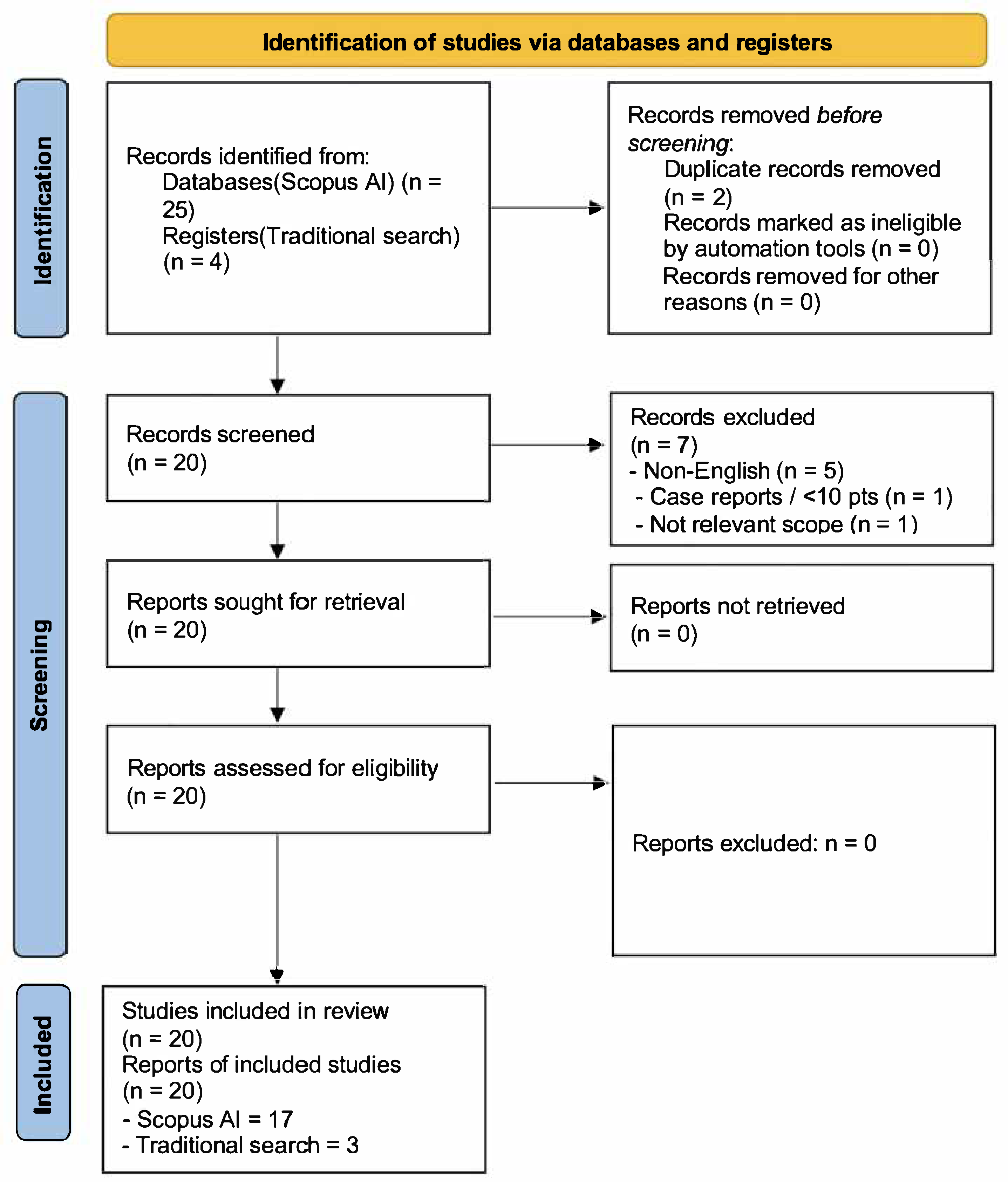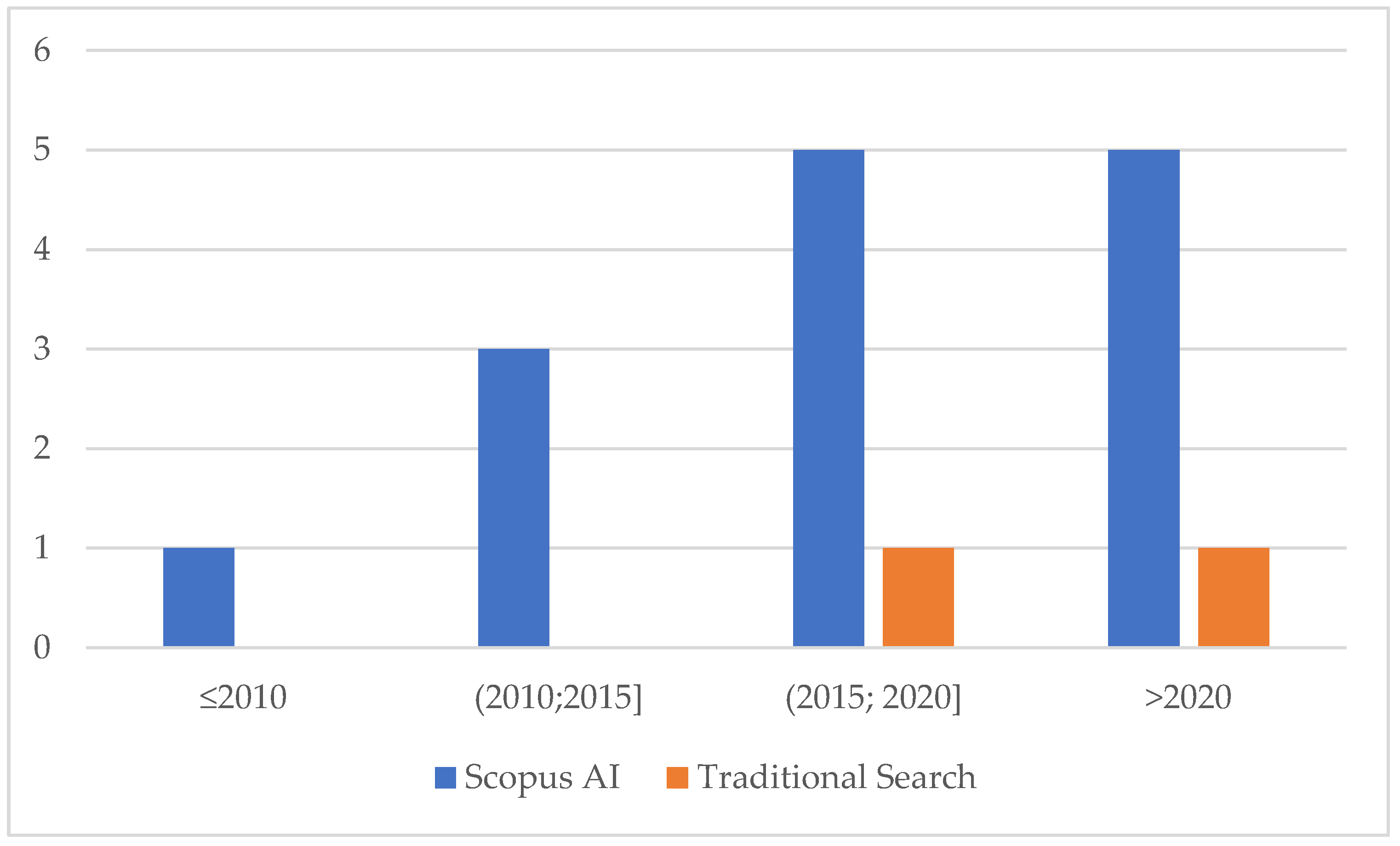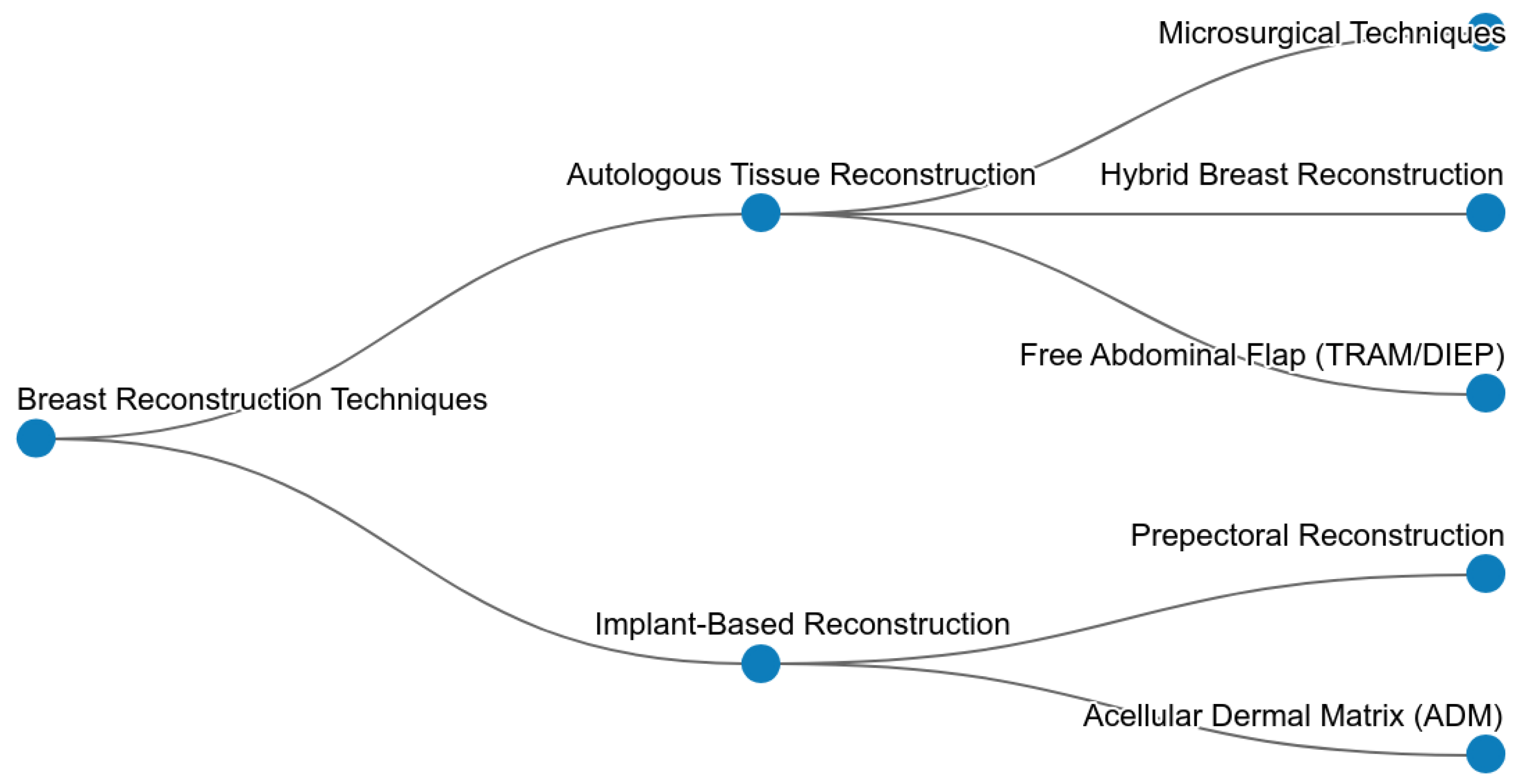Evaluating Scopus AI Versus Traditional Searches for Literature Review About Prepectoral Breast Reconstruction: An Exploratory Study
Abstract
1. Introduction
2. Materials and Methods
2.1. Objective
2.2. Study Selection
2.3. Search Strategy
2.3.1. Scopus AI Methodology
2.3.2. Traditional Keyword Search
2.4. Comparison of Methodologies
2.4.1. Efficiency
2.4.2. Quality of Results
2.4.3. Analysis of Results
3. Results
4. Discussion
4.1. Implications for Future Research
4.2. Enhanced Comprehensiveness
4.3. Improved Accessibility for Novices
4.4. Focused and Manageable Results
4.5. Impact on Breast Reconstruction Research
4.6. Encouraging Interdisciplinary Research
4.7. Limitations
5. Conclusions
5.1. Efficiency and Comprehensiveness of Scopus AI
5.2. Impact on Researchers with Limited Expertise
5.3. Quality and Relevance of Results
5.4. Manual Assessment in Traditional Searches
5.5. Future Research
5.6. Interdisciplinary Research
5.7. General and Contextual Considerations
Author Contributions
Funding
Institutional Review Board Statement
Informed Consent Statement
Data Availability Statement
Conflicts of Interest
References
- Roberts, K.; Mills, N.; Metcalfe, C.; Lane, A.; Clement, C.; Hollingworth, W.; Taylor, J.; Holcombe, C.; Skillman, J.; Fairhurst, K.; et al. Best-BRA: Is subpectoral or prepectoral implant placement best in immediate breast reconstruction? A protocol for a pilot randomised controlled trial of subpectoral versus prepectoral immediate implant-based breast reconstruction in women following mastectomy. BMJ Open 2021, 11, e050886. [Google Scholar] [CrossRef] [PubMed]
- Sbitany, H.; Piper, M.; Lentz, R. Prepectoral breast reconstruction: A safe alternative to submuscular prosthetic reconstruction following nipple-sparing mastectomy. Plast. Reconstr. Surg. 2017, 140, 432–443. [Google Scholar] [CrossRef] [PubMed]
- Lee, J.S.; Park, E.; Lee, J.H.; Lee, J.; Park, H.Y.; Yang, J.D.; Jung, T.-D. A prospective comparison study of early functional outcomes after implant-based breast reconstruction: Subpectoral versus prepectoral technique. Ann. Palliat. Med. 2021, 10, 2520–2529. [Google Scholar] [CrossRef] [PubMed]
- Taj, S.; Chandavarkar, R.; Vidya, R. Current global trends in prepectoral breast reconstruction. Medicina 2024, 60, 431. [Google Scholar] [CrossRef]
- Rebowe, R.E.; Allred, L.J.; Nahabedian, M.Y. The evolution from subcutaneous to prepectoral prosthetic breast reconstruction. Plast. Reconstr. Surg. Glob. Open 2018, 6, e1797. [Google Scholar] [CrossRef]
- Graziano, F.D.; Shay, P.L.; Sanati-Mehrizy, P.; Sbitany, H. Prepectoral implant reconstruction in the setting of postmastectomy radiation. Gland. Surg. 2021, 10, 411–416. [Google Scholar] [CrossRef]
- Sigalove, S. Prepectoral breast reconstruction and radiotherapy—A closer look. Gland. Surg. 2019, 8, 67–74. [Google Scholar] [CrossRef]
- Mégevand, V.; Scampa, M.; McEvoy, H.; Kalbermatten, D.F.; Oranges, C.M. Comparison of outcomes following prepectoral and subpectoral implants for breast reconstruction: Systematic review and meta-analysis. Cancers 2022, 14, 4223. [Google Scholar] [CrossRef]
- Kumbla, P.A.; Ananthasekar, S.B.; Denney, B.D.M. Two-stage, prepectoral breast reconstruction. Ann. Plast. Surg. 2021, 86 (Suppl. 5), S482–S486. [Google Scholar] [CrossRef]
- El Maksoud, W.M.A.; Ahmed, Y.S.; Hamza, A.; Alghamdi, M.A.; Alhashash, M.; Rizk, P.A.; Al Amri, F.S.; Abbas, K.S.; Dalboh, A.; Alzahrani, H.A.; et al. Management of breast cancer by skin-reducing mastectomy and immediate breast reconstruction by prepectoral implant approach with polypropylene mesh for patients with large breasts. Aesthetic Plast. Surg. 2024, 49, 1927–1937. [Google Scholar] [CrossRef]
- Abbas, A.; Rizki, H.; Tanska, A.; Concepcion, M.; Tasoulis, M.K.; Gui, G. A comparative study of secondary procedures after subpectoral and prepectoral single-stage implant-based breast reconstruction. Plast. Reconstr. Surg. 2022, 151, 7–15. [Google Scholar] [CrossRef]
- Onesti, M.; Di Taranto, G.; Ribuffo, D.; Scuderi, N. ADM-assisted prepectoral breast reconstruction and skin reduction mastectomy: Expanding the indications for subcutaneous reconstruction. J. Plast. Reconstr. Aesthetic Surg. 2020, 73, 673–680. [Google Scholar] [CrossRef]
- Visnjic, M.; Kovacevic, P.; Paunkovic, L.; Djordjevic, G.; Budjevac, D.; Visnjic, A. Breast reconstruction following amputation for cancer. Vojn. Pregl. 2009, 66, 427–433. [Google Scholar] [CrossRef] [PubMed]
- Ma, J.X.; Xia, Y.C.; Li, B.; Zhao, H.M.; Lei, Y.T.; Bu, X. Choice of immediate breast reconstructive methods after modified radical mastectomy. Beijing Da Xue Xue Bao Yi Xue Ban 2023, 55, 612–618. [Google Scholar] [CrossRef] [PubMed]
- Rezai, M.; Darsow, M.; Kümmel, S.; Krämer, S. Autologous and alloplastic breast reconstruction—Overview of techniques, indications and results. Gynakol Geburtshilfliche Rundsch. 2008, 48, 68–75. [Google Scholar] [CrossRef] [PubMed]
- Talwar, A.A.M.; Lanni, M.A.; Ryan, I.A.B.; Kodali, P.B.; Bernstein, E.B.; McAuliffe, P.B.B.; Broach, R.B.; Serletti, J.M.; Butler, P.D.; Fosnot, J. Prepectoral vs submuscular implant-based breast reconstruction: A matched-pair comparison of outcomes. Plast. Reconstr. Surg. 2023, 153, 281e–290e. [Google Scholar] [CrossRef]
- Kronowitz, S.J.; Kuerer, H.M. Advances and surgical decision-making for breast reconstruction. Cancer 2006, 107, 893–907. [Google Scholar] [CrossRef]
- Fredman, R.; Wu, C.; Rapolti, M.; Luckett, D.; Fine, J.; McGuire, K.; Gallagher, K.; Roughton, M. Prepectoral direct-to-implant breast reconstruction: Early outcomes and analysis of postoperative pain. Aesthetic Surg. J. Open Forum 2019, 1, ojz006. [Google Scholar] [CrossRef]
- Rugină, A.I.; Ungureanu, A.; Giuglea, C.; Marinescu, S.A. Artificial intelligence in breast reconstruction: A narrative review. Medicina 2025, 61, 440. [Google Scholar] [CrossRef]
- Shi, Y.-C.; Li, J.; Li, S.-J.; Li, Z.-P.; Zhang, H.-J.; Wu, Z.-Y.; Wu, Z.-Y. Flap failure prediction in microvascular tissue reconstruction using machine learning algorithms. World J. Clin. Cases 2022, 10, 3729–3738. [Google Scholar] [CrossRef]
- Mansoor, M.; Ibrahim, A.F. The transformative role of artificial intelligence in plastic and reconstructive surgery: Challenges and opportunities. J. Clin. Med. 2025, 14, 2698. [Google Scholar] [CrossRef]



| Category | Explanation |
|---|---|
| Primary Prepectoral Breast Reconstruction After Radical Mastectomy | Prepectoral breast reconstruction (PPBR) has gained popularity as a technique for breast reconstruction following mastectomy due to its numerous advantages over traditional subpectoral methods. This summary provides an overview of the benefits, complications, and outcomes associated with PPBR based on recent studies. |
| Advantages of Prepectoral Breast Reconstruction: | |
| Complications and Considerations: | |
| Clinical Outcomes: |
|
| Aspect | Prepectoral | Subpectoral |
|---|---|---|
| Postoperative Pain | Lower [1,2,3] | Higher [1,2,3] |
| Esthetic Outcomes | Improved [4,5] | Comparable [4,5] |
| Complication Rates | Lower capsular contracture [6,7] | Similar overall [2,6,8] |
| Patient Satisfaction | High [4,10,11] | High [4,10,11] |
| Functional Recovery | Faster [3] | Slower [3] |
| Category | Explanation |
|---|---|
| Surgical Techniques: |
|
| Advantages and Disadvantages: |
|
| Patient Selection Considerations: |
|
| Long-term Outcomes and Complications: |
|
| Theme Name (with References) | Definition | Potential Hypothesis (with Hyperlinks) |
|---|---|---|
| Patient Satisfaction and Quality of Life in Prepectoral Breast Reconstruction | The consistent interest in patient satisfaction and quality of life following prepectoral breast reconstruction highlights the importance of understanding patient-centered outcomes. This theme is crucial for improving surgical techniques and postoperative care to enhance patient experiences and satisfaction. |
|
| Advancements in Acellular Dermal Matrix (ADM) Utilization | The ongoing research into the use of acellular dermal matrices (ADM) in prepectoral breast reconstruction indicates a sustained interest in optimizing surgical outcomes and reducing complications. This theme is vital for developing new materials and techniques to improve the safety and efficacy of breast reconstruction procedures. |
|
| Innovations in Imaging and Measurement Techniques for Breast Reconstruction | The rising interest in advanced imaging and measurement techniques for prepectoral breast reconstruction reflects the need for precise preoperative planning and postoperative assessment. These innovations are crucial for improving surgical accuracy and patient outcomes. |
|
| Nipple-Sparing Mastectomy and Prepectoral Reconstruction | The increasing focus on nipple-sparing mastectomy combined with prepectoral reconstruction highlights the trend towards more conservative and esthetically favorable surgical options. This approach aims to preserve the nipple-areolar complex while providing effective reconstruction, which is significant for patient satisfaction and cosmetic outcomes. |
|
| Prepectoral Tissue Expander Techniques | The novel focus on prepectoral tissue expander techniques without the use of acellular dermal matrix (ADM) represents a new direction in breast reconstruction research. This theme explores the feasibility, safety, and outcomes of using tissue expanders in a prepectoral plane, which could offer alternative options for patients and surgeons. |
|
| What are the key considerations for patient selection in primary prepectoral breast reconstruction? How does primary prepectoral breast reconstruction compare to subpectoral reconstruction in terms of outcomes and complications? What are the potential challenges and limitations of primary prepectoral breast reconstruction after radical mastectomy? |
Disclaimer/Publisher’s Note: The statements, opinions and data contained in all publications are solely those of the individual author(s) and contributor(s) and not of MDPI and/or the editor(s). MDPI and/or the editor(s) disclaim responsibility for any injury to people or property resulting from any ideas, methods, instructions or products referred to in the content. |
© 2025 by the authors. Licensee MDPI, Basel, Switzerland. This article is an open access article distributed under the terms and conditions of the Creative Commons Attribution (CC BY) license (https://creativecommons.org/licenses/by/4.0/).
Share and Cite
Ciule, I.Ș.; Cordos, A.-A.; Ciocan, R.A.; Ciocan, A.; Muntean, M.V.; Gherman, C.D. Evaluating Scopus AI Versus Traditional Searches for Literature Review About Prepectoral Breast Reconstruction: An Exploratory Study. Med. Sci. 2025, 13, 211. https://doi.org/10.3390/medsci13040211
Ciule IȘ, Cordos A-A, Ciocan RA, Ciocan A, Muntean MV, Gherman CD. Evaluating Scopus AI Versus Traditional Searches for Literature Review About Prepectoral Breast Reconstruction: An Exploratory Study. Medical Sciences. 2025; 13(4):211. https://doi.org/10.3390/medsci13040211
Chicago/Turabian StyleCiule, Ionuț Ștefan, Ariana-Anamaria Cordos, Răzvan Alexandru Ciocan, Andra Ciocan, Maximilian Vlad Muntean, and Claudia Diana Gherman. 2025. "Evaluating Scopus AI Versus Traditional Searches for Literature Review About Prepectoral Breast Reconstruction: An Exploratory Study" Medical Sciences 13, no. 4: 211. https://doi.org/10.3390/medsci13040211
APA StyleCiule, I. Ș., Cordos, A.-A., Ciocan, R. A., Ciocan, A., Muntean, M. V., & Gherman, C. D. (2025). Evaluating Scopus AI Versus Traditional Searches for Literature Review About Prepectoral Breast Reconstruction: An Exploratory Study. Medical Sciences, 13(4), 211. https://doi.org/10.3390/medsci13040211







